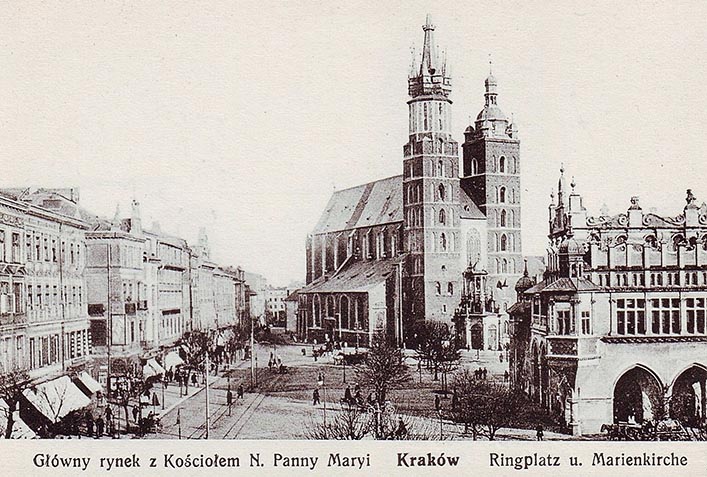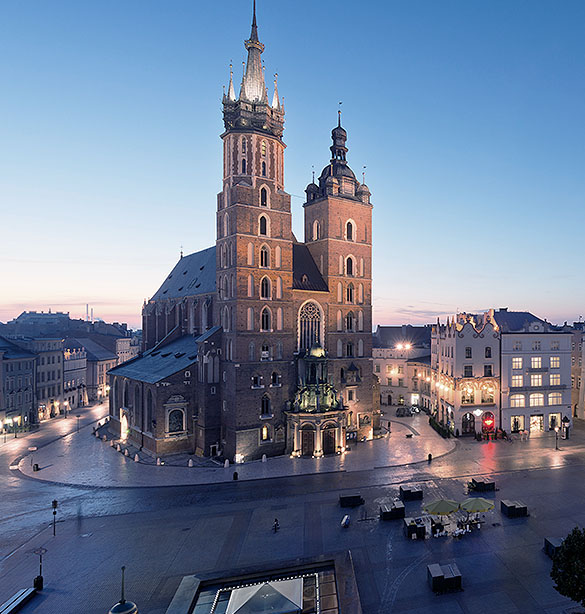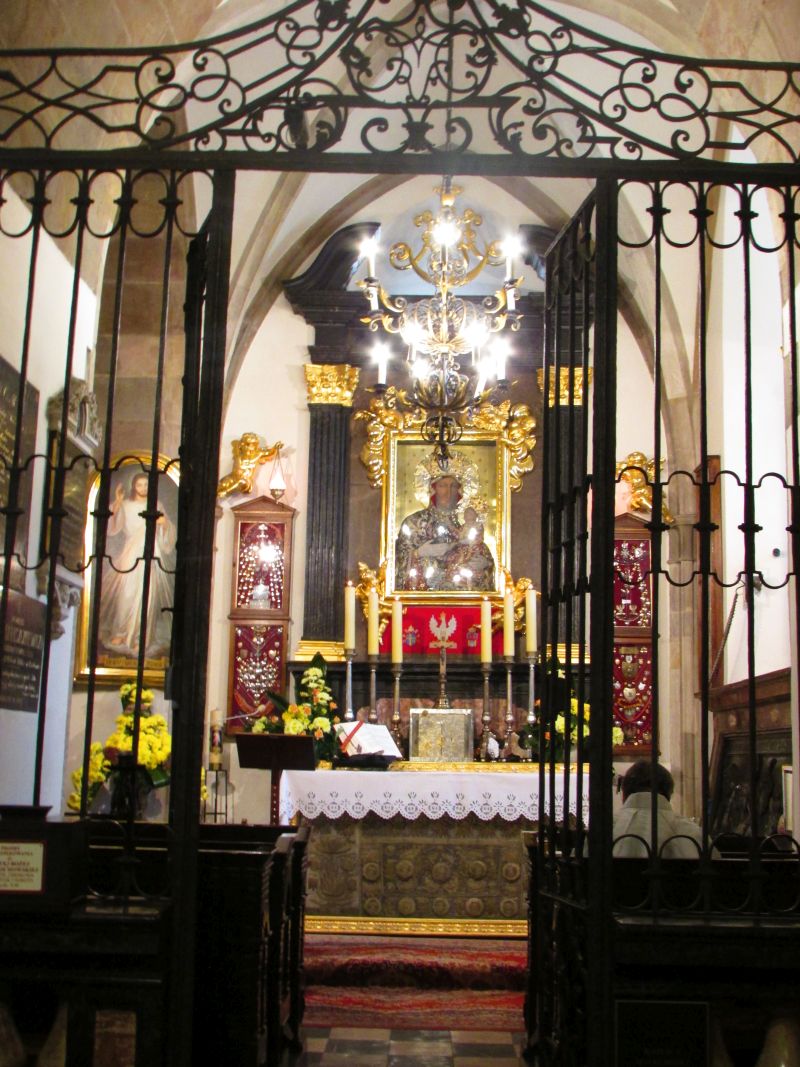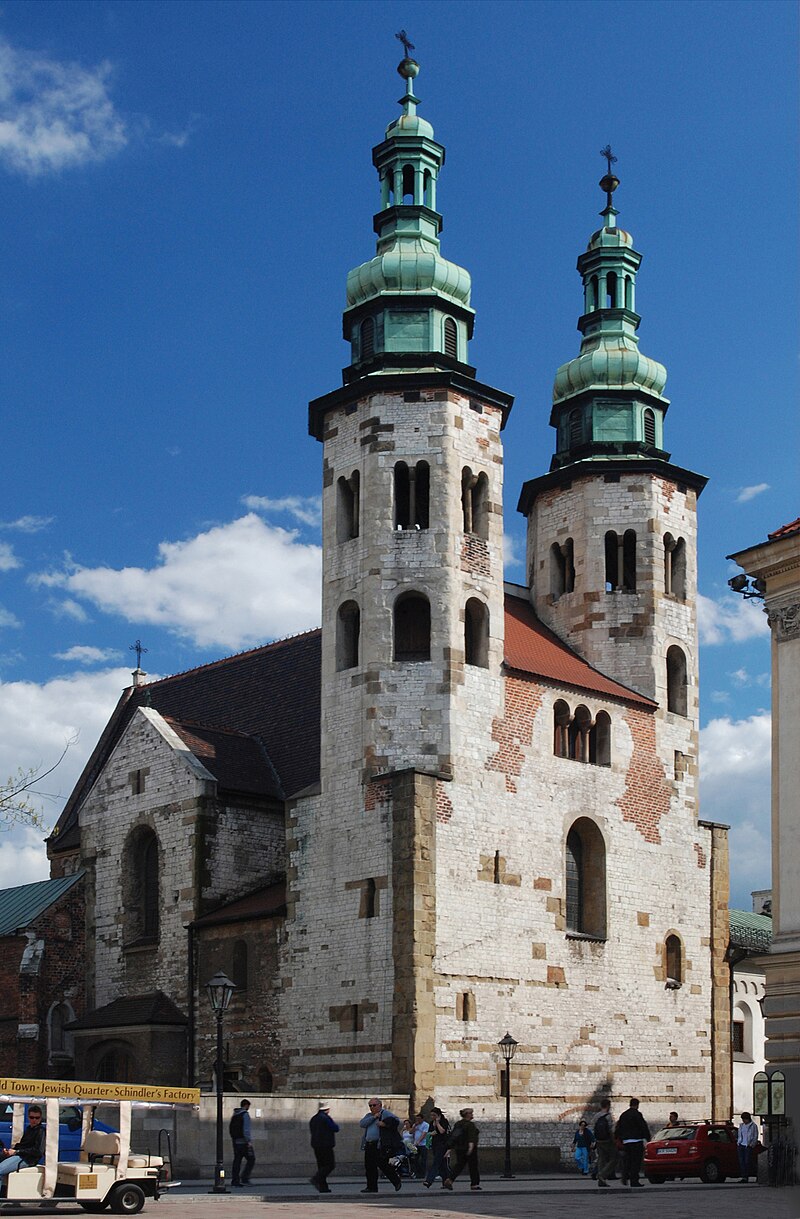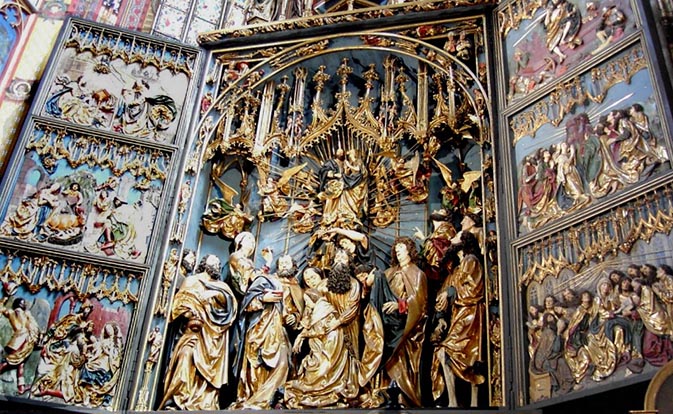 Wnętrze
Wnętrze
Aby najpełniej doświadczyć wspaniałości wnętrza, najlepiej wejść od strony Rynku, przez misternie rzeźbione drzwi. Kościół jest bardzo smukły i wysoki – w nawie głównej ma 28 m. Wnętrze wręcz bombarduje zmysły bogactwem detali. Nastrój intensyfikuje pokrywająca ciemne ściany polichromia Matejki podobna do dywanów Szecherezady. Nad całością roztacza się szafirowe sklepienie usiane złotymi gwiazdami. Jednak aby obejrzeć słynny ołtarz Wita Stwosza, trzeba wejść do kościoła od strony południowej. Wprowadzono bowiem ścisły podział na część dla zwiedzających i dla modlących się. Przy oznaczonym wejściu dla turystów należy kupić bilet uprawniający do zwiedzenia prezbiterium.
Ołtarz Wita Stwosza
Ołtarz mariacki jest pentaptykiem o wysokości 13 m i szerokości 11 m, składającym się z szafy środkowej, jednej pary skrzydeł ruchomych i jednej pary skrzydeł nieruchomych. W podstawie znajduje się predella, a górną część przykrywa ażurowe zwieńczenie. W ołtarzu doliczono się dwustu rzeźbionych figur wielkości od 3 cm do 3 m. Główna myśl teologiczna, przyświecająca Stwoszowi w,realizacji dzieła, nawiązywała do późnośredniowiecznej interpretacji roli Matki Przenajświętszej w odkupieniu świata. Centralna scena przedstawia grupę pogrążonych w żalu apostołów otaczających Marię, która osuwa się w ramiona Jakuba. Warto zauważyć, że Maria została przedstawiona jako młoda i delikatna kobieta, przepełniona lirycznym spokojem.
W taki sposób Stwosz wyraził bezbolesny i radosny charakter „Zaśnięcia Marii”, która zaraz potem połączyła się ze swoim Synem w niebie, co widać w górnej części centralnej sceny. Figury apostołów wyrzeźbione w drewnie lipowym mają ponad 3 m wysokości. Ich twarze są silnie zindywidualizowane, pełne wyrazu i prawdy psychologicznej, ciała wyginają się w dynamicznych pozach, a szaty marszczy niewyczuwalny podmuch wiatru. Z bliska widać, z jaką znajomością szczegółów anatomii wyciosał Stwosz swoje postaci: na szyjach prężą się żyły, na twarzach widać zmarszczki, pod skórą rąk i nóg wybrzuszają się ścięgna i mięśnie. Tłum figur w retabulum, czyli wnęce szafy ołtarza, mnogość drobniejszych rzeźb, detali i ozdobników w niczym nie zakłóca harmonii i realizmu sceny. Wydaje się, jakby postaci z głównej komory ołtarzowej tylko na chwilę zastygły w bezruchu, aby za moment ożyć. Na bocznych ruchomych skrzydłach widnieją płaskorzeźbione sceny: po prawej stronie, patrząc od góry, widać: Zmartwychwstanie, Wniebowstąpienie, Zesłanie Ducha Świętego, a po lewej od góry: Zwiastowanie, Boże Narodzenie, Pokłon Trzech Króli.
U podstawy ołtarza znajduje się predella z wyobrażeniem Drzewa Jessego, a w szczytowej partii ołtarza wznosi się kompozycja przedstawiająca koronację Matki Boskiej przez Boga Ojca i Chrystusa. Po bokach stoją dwaj patroni Polski: św. Stanisław i św. Wojciech.
W nawie głównej oprócz ciągu XVIII-wiecznych ołtarzy z marmuru, w których umieszczone są obrazy takich malarzy, jak: Jan Baptysta Pittoni czy Łukasz Orłowski, znajdują się interesujące stalle, w których zasiadali radni miejscy oraz członkowie patrycjatu.
Kiedy ołtarz jest zamknięty, można podziwiać inne sceny z życia Marii i Jezusa oddane z niezwykłą precyzja rzeźbiarza-realisty. które stanowią swoisty „elementarz” realiów średniowiecznego Krakowa, dostarczając wiedzy na temat strojów, fryzur, szczegółów wystroju wnętrz. Z analizy tych właśnie realistycznie oddanych drobiazgów współcześni badacze czerpali na przykład wiedzę o chorobach skóry istniejących w średniowieczu.
